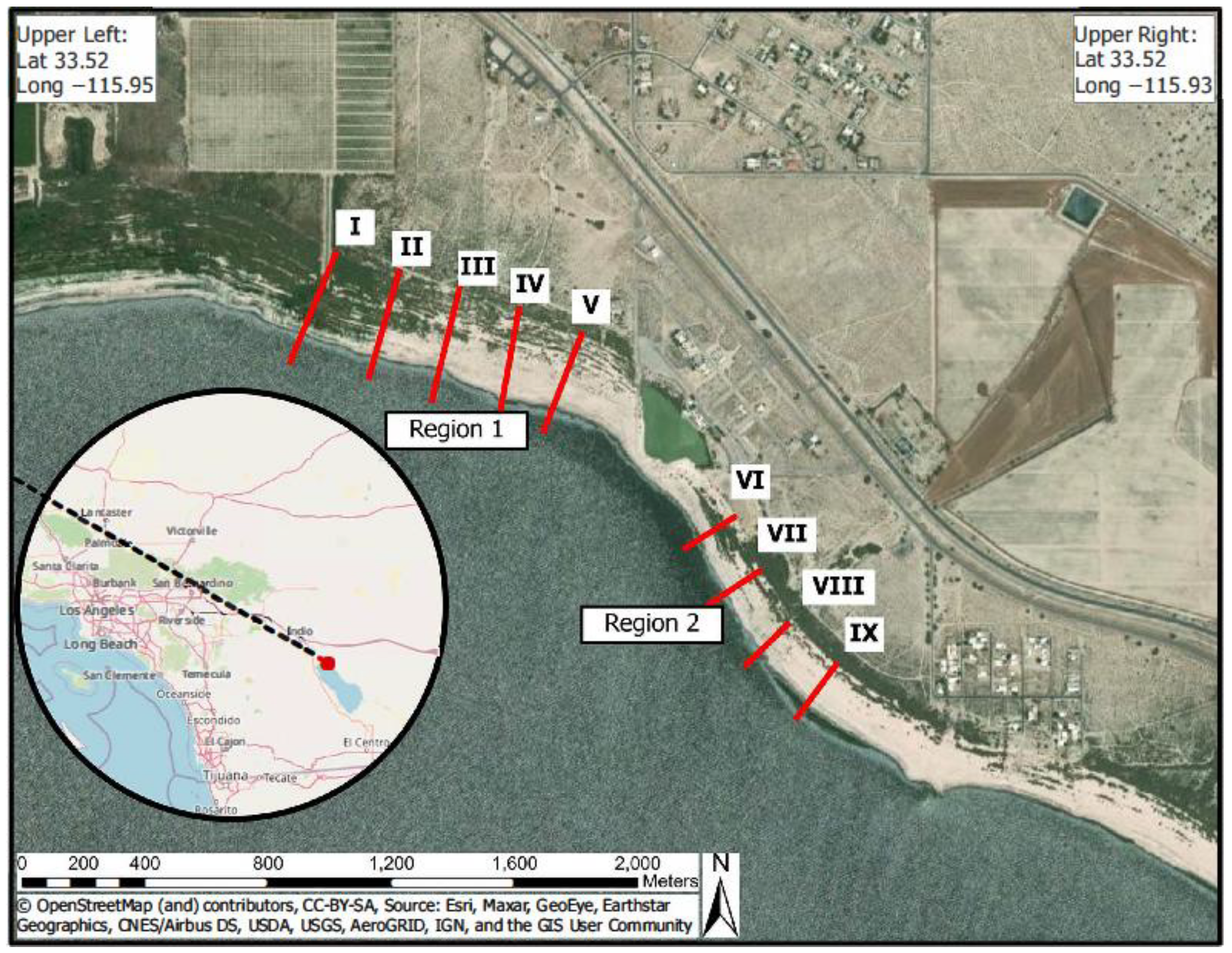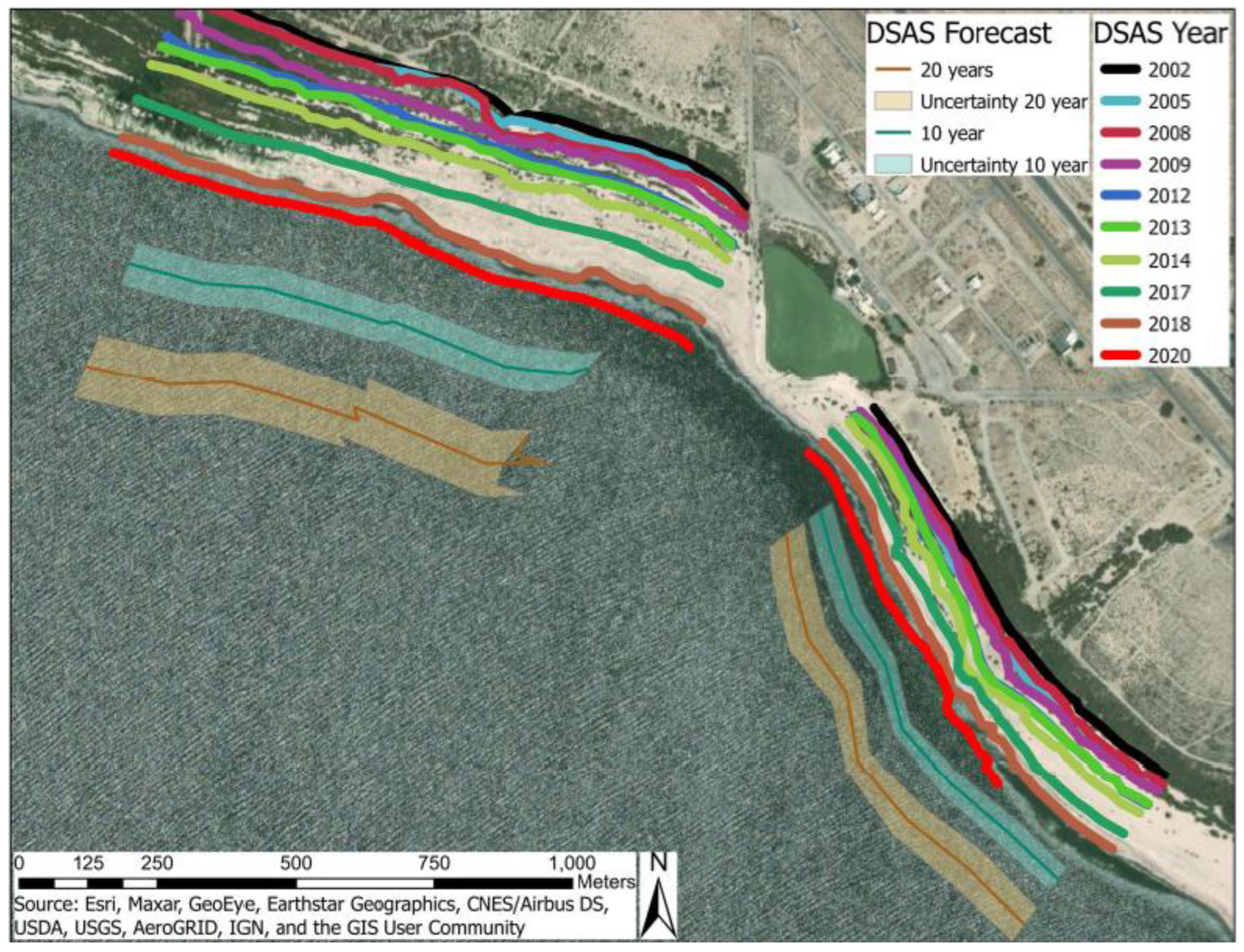A Balloon Mapping Approach to Forecast Increases in PM10 from the Shrinking Shoreline of the Salton Sea
Abstract
:1. Introduction
2. Materials and Methods
2.1. Study Area
2.2. Community Methods
2.3. Data Sources and Image Acquisition
2.4. Image Processing and Analysis
2.5. Shoreline Forecasting
2.6. PM10 Forecasting
3. Results
3.1. Shoreline Monitoring
3.2. Shoreline Forecasting
3.3. PM10 Forecasting
4. Discussion
5. Conclusions
Author Contributions
Funding
Data Availability Statement
Acknowledgments
Conflicts of Interest
References
- Tompson, A.F.B. Born from a Flood: The Salton Sea and Its Story of Survival. J. Earth Sci. 2016, 27, 89–97. [Google Scholar] [CrossRef]
- Wilke, P.J. Late Prehistoric Human Ecology at Lake Cahuilla Coachella Valley, California; University of California Archaeological Research Facility: Berkeley, CA, USA, 1978. [Google Scholar]
- Waters, M.R. Late Holocene Lacustrine Chronology and Archaeology of Ancient Lake Cahuilla, California. Quat. Res. 1983, 19, 373–387. [Google Scholar] [CrossRef]
- King, J.; Etyemezian, V.; Sweeney, M.; Buck, B.J.; Nikolich, G. Dust Emission Variability at the Salton Sea, California, USA. Aeolian Res. 2011, 3, 67–79. [Google Scholar] [CrossRef]
- Voyles, T.B. The Settler Sea: California’s Salton Sea and the Consequences of Colonialism; University of Nebraska Press: Lincoln, NE, USA, 2021; ISBN 978-1-4962-1673-1. [Google Scholar]
- Schwabe, K. The Salton Sea: An Introduction to an Evolving System and the Role of Science. Calif. Agric. 2022, 76, 4–7. [Google Scholar] [CrossRef]
- Lee, M.-C.; Stenstrom, M.K. Water Quality Mitigation Strategy Analysis of the Salton Sea, California, Using the Delft-3D modeling suite. Front. Sustain. Resour. Manag. 2023, 2, 1178038. [Google Scholar] [CrossRef]
- Lan, J.; Liu, P.; Hu, X.; Zhu, S. Harmful Algal Blooms in Eutrophic Marine Environments: Causes, Monitoring, and Treatment. Water 2024, 16, 2525. [Google Scholar] [CrossRef]
- Frie, A.L.; Dingle, J.H.; Ying, S.C.; Bahreini, R. The Effect of a Receding Saline Lake (The Salton Sea) on Airborne Particulate Matter Composition. Environ. Sci. Technol. 2017, 51, 8283–8292. [Google Scholar] [CrossRef] [PubMed]
- Parajuli, S.P.; Zender, C.S. Projected Changes in Dust Emissions and Regional Air Quality due to the Shrinking Salton Sea. Aeolian Res. 2018, 33, 82–92. [Google Scholar] [CrossRef]
- Centeno, D.; Arzeno-Soltero, I.; Delgado, A.; Freilich, M.; Marquez, C.; Montgomery, Q.; Palomino, A.; Penalber, G.; Sinclair, R.; Taboada, J. Salton Sea Environmental Work and the Importance of Community Science. Oceanography 2023, 36, 136–137. [Google Scholar] [CrossRef]
- Balloon Mapping: How to Make Your Low-Flying Satellite. Available online: https://geojournalism.org/2013/08/balloon-mapping-how-to-make-your-own-low-flying-satellite/ (accessed on 4 October 2020).
- Google Earth. (n.d.). Google Earth Pro Satellite Imagery Maps from 2002–2018 for the North Shore Yacht Club, Thermal, Riverside County, California, USA 33°31′06″ N 115°56′20″ W. Available online: https://earth.google.com/web/@33.51850527,-115.93987189 (accessed on 27 August 2021).
- OpenDroneMap. (n.d.). OpenDroneMap 3.0.5 Documentation and Getting Started. Available online: https://docs.opendronemap.org/installation/#quickstart (accessed on 27 August 2021).
- Crowell, B.W.; Bock, Y.; Sandwell, D.T.; Fialko, Y. Geodetic Investigation into the Deformation of the Salton Trough. J. Geophys. Res. Solid Earth 2013, 118, 5030–5039. [Google Scholar] [CrossRef]
- Genz, A.S.; Fletcher, C.H.; Dunn, R.A.; Frazer, L.N.; Rooney, J.J. The Predictive Accuracy of Shoreline Change Rate Methods and Alongshore Beach Variation on Maui, Hawaii. J. Coast. Res. 2007, 2007, 87–105. [Google Scholar] [CrossRef]
- Himmelstoss, E.A.; Henderson, R.E.; Kratzmann, M.G.; Farris, A.S. Digital Shoreline Analysis System (DSAS) Version 5.0 User Guide; U.S. Geological Survey: Reston, VA, USA, 2018.
- Parajuli, S.P.; Zender, C.S. Connecting Geomorphology to Dust Emission through High-Resolution Mapping of Global Land Cover and Sediment Supply. Aeolian Res. 2017, 27, 47–65. [Google Scholar] [CrossRef]
- Biddle, T.A.; Yisrael, K.; Drover, R.; Li, Q.; Maltz, M.R.; Topacio, T.M.; Yu, J.; Del Castillo, D.; Gonzales, D.; Freund, H.L.; et al. Aerosolized Aqueous Dust Extracts Collected near a Drying Lake Trigger Acute Neutrophilic Pulmonary Inflammation Reminiscent of Microbial Innate Immune Ligands. Sci. Total Environ. 2023, 858, 159882. [Google Scholar] [CrossRef] [PubMed]
- CH2MHILL. Salton Sea Hydrological Modeling and Results; CH2MHILL: San Diego, CA, USA, 2018. [Google Scholar]
- Imperial Irrigation District. News & Resources, IID Acts to Protect Colorado River, Salton Sea with New Conservation Agreement. Available online: https://www.iid.com/Home/Components/News/News/1207/30 (accessed on 20 August 2024).
- Abman, R.; Edwards, E.C.; Hernandez-Cortes, D. Water, Dust, and Environmental Justice: The Case of Agricultural Water Diversions. Am. J. Agric. Econ. 2024, 1–18. [Google Scholar] [CrossRef]
- Farzan, S.F.; Razafy, M.; Eckel, S.P.; Olmedo, L.; Bejarano, E.; Johnston, J.E. Assessment of Respiratory Health Symptoms and Asthma in Children near a Drying Saline Lake. Int. J. Environ. Res. Public Health 2019, 16, 3828. [Google Scholar] [CrossRef] [PubMed]
- Mendoza, D.L.; Pirozzi, C.S.; Crosman, E.T.; Liou, T.G.; Zhang, Y.; Cleeves, J.J.; Bannister, S.C.; Anderegg, W.R.L.; Robert, P.I. Impact of Low-Level Fine Particulate Matter and Ozone Exposure on Absences in K-12 Students and Economic Consequences. Environ. Res. Lett. 2020, 15, 114052. [Google Scholar] [CrossRef]




| Regions | Shoreline Segment | Net Shoreline Movement (m) | Average NSM | End Point Rates (m/year) | Average EPR |
|---|---|---|---|---|---|
| Region 1 | I | −313.98 | 297.46 | −17.59 | 16.66 |
| II | −286.89 | −16.07 | |||
| III | −295.73 | −16.57 | |||
| IV | −299.60 | −16.78 | |||
| V | −291.10 | −16.30 | |||
| Region 2 | VI | −146.12 | 161.26 | −8.35 | 9.38 |
| VII | −161.33 | −9.22 | |||
| VIII | −172.17 | −9.83 | |||
| IX | −165.44 | −10.13 |
| Shoreline Segment | Net Shoreline Movement (m) 2002–2017 | End Point Rates (m/year) 2002–2017 | Net Shoreline Movement (m) 2017–2020 | End Point Rates (m/year) 2017–2020 |
|---|---|---|---|---|
| I | −209.55 | −13.89 | −97.63 | −35.28 |
| II | −188.70 | −12.51 | −96.67 | −34.94 |
| III | −190.83 | −12.65 | −107.36 | −38.80 |
| IV | −182.62 | −12.10 | −109.98 | −39.74 |
| V | −173.85 | −11.52 | −120.21 | −43.44 |
| VI | −79.83 | −5.29 | −63.91 | −25.55 |
| VII | −98.83 | −6.55 | −69.88 | −27.94 |
| VIII | −120.66 | −8.00 | −68.28 | −27.30 |
| IX | −131.15 | −8.69 | −59.53 | −23.80 |
| Regions | Forecast Year | Average Distance in Meters from 2002 Shoreline | Average Distance in Meters from 2020 Shoreline |
|---|---|---|---|
| Region 1 | 2031 | 447.6 | 150.7 |
| 2041 | 628.9 | 332.1 | |
| Region 2 | 2031 | 237.9 | 77.7 |
| 2041 | 330.1 | 169.9 |
Disclaimer/Publisher’s Note: The statements, opinions and data contained in all publications are solely those of the individual author(s) and contributor(s) and not of MDPI and/or the editor(s). MDPI and/or the editor(s) disclaim responsibility for any injury to people or property resulting from any ideas, methods, instructions or products referred to in the content. |
© 2024 by the authors. Licensee MDPI, Basel, Switzerland. This article is an open access article distributed under the terms and conditions of the Creative Commons Attribution (CC BY) license (https://creativecommons.org/licenses/by/4.0/).
Share and Cite
Sinclair, R.G.; Gaio, J.; Huazano, S.D.; Wiafe, S.A.; Porter, W.C. A Balloon Mapping Approach to Forecast Increases in PM10 from the Shrinking Shoreline of the Salton Sea. Geographies 2024, 4, 630-640. https://doi.org/10.3390/geographies4040034
Sinclair RG, Gaio J, Huazano SD, Wiafe SA, Porter WC. A Balloon Mapping Approach to Forecast Increases in PM10 from the Shrinking Shoreline of the Salton Sea. Geographies. 2024; 4(4):630-640. https://doi.org/10.3390/geographies4040034
Chicago/Turabian StyleSinclair, Ryan G., Josileide Gaio, Sahara D. Huazano, Seth A. Wiafe, and William C. Porter. 2024. "A Balloon Mapping Approach to Forecast Increases in PM10 from the Shrinking Shoreline of the Salton Sea" Geographies 4, no. 4: 630-640. https://doi.org/10.3390/geographies4040034
APA StyleSinclair, R. G., Gaio, J., Huazano, S. D., Wiafe, S. A., & Porter, W. C. (2024). A Balloon Mapping Approach to Forecast Increases in PM10 from the Shrinking Shoreline of the Salton Sea. Geographies, 4(4), 630-640. https://doi.org/10.3390/geographies4040034







